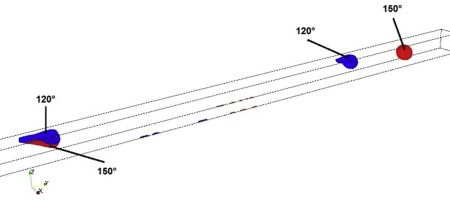International Journal of Hydrogen Energy ( IF 8.1 ) Pub Date : 2018-01-10 , DOI: 10.1016/j.ijhydene.2017.12.129 M. Andersson , S.B. Beale , U. Reimer , W. Lehnert , D. Stolten

|
With the increased concern about energy security, air pollution and global warming, the possibility of using polymer electrolyte fuel cells (PEFCs) in future sustainable and renewable energy systems has achieved considerable momentum. A computational fluid dynamic model describing a straight channel, relevant for water removal inside a PEFC, is devised. A volume of fluid (VOF) approach is employed to investigate the interface resolved two-phase flow behavior inside the gas channel including the gas diffusion layer (GDL) surface. From this study, it is clear that the impact on the two-phase flow pattern for different hydrophobic/hydrophilic characteristics, i.e., contact angles, at the walls and at the GDL surface is significant, compared to a situation where the walls and the interface are neither hydrophobic nor hydrophilic (i.e., 90° contact angle at the walls and also at the GDL surface). A location of the GDL surface liquid inlet in the middle of the gas channel gives droplet formation, while a location at the side of the channel gives corner flow with a convex surface shape (having hydrophilic walls and a hydrophobic GDL interface). Droplet formation only observed when the GDL surface liquid inlet is located in the middle of the channel. The droplet detachment location (along the main flow direction) and the shape of the droplet until detachment are strongly dependent on the size of the liquid inlet at the GDL surface. A smaller liquid inlet at the GDL surface (keeping the mass flow rates constant) gives smaller droplets.
中文翻译:

使用流体体积方法在与聚合物电解质燃料电池相关的气体通道中进行界面解析两相流模拟
随着人们对能源安全,空气污染和全球变暖的关注日益增加,在未来的可持续和可再生能源系统中使用聚合物电解质燃料电池(PEFC)的可能性已获得了可观的动力。设计了一种计算流体动力学模型,该模型描述了一条与PEFC内部除水有关的直通道。流体体积(VOF)方法用于研究包括气体扩散层(GDL)表面在内的气体通道内部的界面解析两相流动行为。通过这项研究,很明显,与壁和界面的情况相比,不同的疏水/亲水特性(即壁和GDL表面的接触角)对两相流模式的影响是显着的。既不疏水也不亲水(即,壁和GDL表面的接触角均为90°)。GDL表面液体入口在气体通道中间的位置会形成液滴,而在通道侧面的位置会产生具有凸表面形状(具有亲水壁和疏水性GDL界面)的角流。仅当GDL表面液体入口位于通道中间时才能观察到液滴形成。液滴分离的位置(沿主流动方向)和直到分离的液滴的形状在很大程度上取决于GDL表面处液体入口的大小。GDL表面较小的液体入口(保持质量流量恒定)会产生较小的液滴。而通道侧面的位置会产生具有凸面形状(具有亲水壁和疏水性GDL界面)的拐角流动。仅当GDL表面液体入口位于通道中间时才能观察到液滴形成。液滴分离的位置(沿主流动方向)和直到分离的液滴的形状在很大程度上取决于GDL表面处液体入口的大小。GDL表面较小的液体入口(保持质量流量恒定)会产生较小的液滴。而通道侧面的位置会产生具有凸面形状(具有亲水壁和疏水性GDL界面)的拐角流动。仅当GDL表面液体入口位于通道中间时才能观察到液滴形成。液滴分离的位置(沿主流动方向)和直到分离的液滴的形状在很大程度上取决于GDL表面处液体入口的大小。GDL表面较小的液体入口(保持质量流量恒定)会产生较小的液滴。液滴分离的位置(沿主流动方向)和直到分离的液滴的形状在很大程度上取决于GDL表面处液体入口的大小。GDL表面较小的液体入口(保持质量流量恒定)会产生较小的液滴。液滴分离的位置(沿主流动方向)和直到分离的液滴的形状在很大程度上取决于GDL表面处液体入口的大小。GDL表面较小的液体入口(保持质量流量恒定)会产生较小的液滴。











































 京公网安备 11010802027423号
京公网安备 11010802027423号